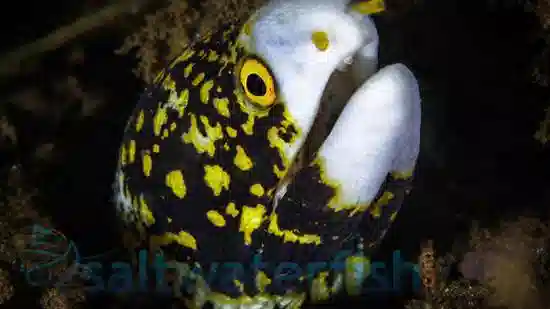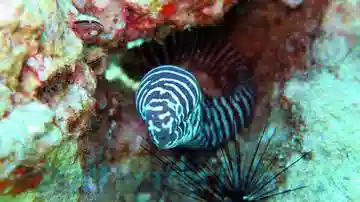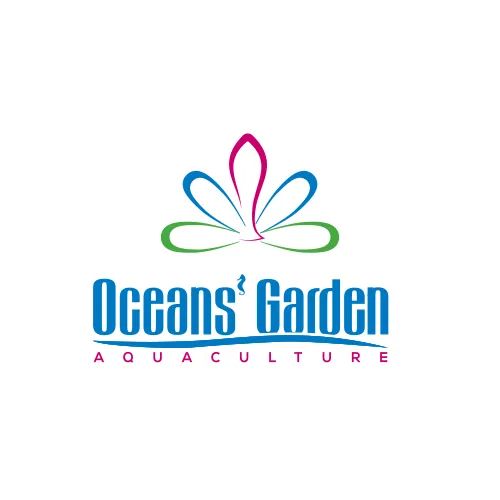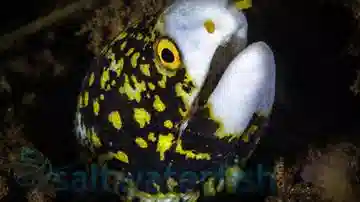Snowflake Eel
Echidna nebulosa
(0 Reviews)

Snowflake Eel
Echidna nebulosa
(0 Reviews)
{{ item.name }}
Size: {{ item.extra_field_3 }}
${{ getFormattedPrice(item.saleprice) }} ${{ getFormattedPrice(item.price) }}
To join the waiting list, click here
Free Shipping
With
$199.00
or more in Marine Life.
More details...
Snowflake Eel Care Facts
| Size: | 7-8.5 inches |
|---|---|
| Care Level: | Easy |
| Temperament: | Semi-aggressive |
| Diet: | Carnivore |
| Origin: | Indo Pacific |
| Acclimation Time: | 3+ Hours |
| Reef Safe: | Monitor |
| Coral Safe: | Yes |
| Invertebrate Safe: | No |
| Minimum Tank Size: | 50+ Gallons |
The Snowflake Eel: A Captivating Addition to Your Saltwater Marine Aquarium
The Snowflake Eel (Echidna nebulosa) is a fascinating and popular choice for enthusiasts in the saltwater marine aquarium hobby. Known for its distinctive appearance and unique behaviors, this eel species can be a captivating addition to your marine setup. In this comprehensive guide, we will delve into various aspects of keeping the Snowflake Eel, offering valuable insights into its habitat, reef compatibility, size, lifespan, diet in captivity, aquaculture availability, compatibility with other marine life, sexual dimorphism, coloration changes, temperament, tank requirements, and precise water conditions.
Habitat and Origin: Exploring the Natural Environment of Snowflake Eel
The Snowflake Eel is native to the Indo-Pacific region, inhabiting coastal areas, coral reefs, and rocky crevices. These eels are found in various environments in the wild, from shallow waters to depths of around 200 feet. When recreating their habitat in captivity, providing an environment miming the rocky crevices and hiding spots they would naturally seek out is crucial.
Reef Compatibility: Ensuring Harmony in Your Aquarium with Snowflake Eel
One of the critical considerations for marine hobbyists is whether a species is reef-safe. The Snowflake Eel is not considered reef-safe. Caution should be exercised when selecting tank mates, significantly smaller fish, or crustaceans, as the Snowflake Eel may see them as potential prey.
Size and Lifespan: Understanding the Growth and Longevity of Snowflake Eel
Snowflake Eels start as small juveniles, typically around 6 inches, but can grow substantially, reaching up to 24 inches or more in captivity. They have an impressive lifespan, often lasting 15 years or longer when provided with proper care.
Diet in Captivity: Nourishing Your Snowflake Eel
Snowflake Eels are carnivores and have a voracious appetite. In captivity, they readily accept a diet of various meaty foods, such as frozen shrimp, squid, and other marine-based preparations. A well-rounded diet is essential to ensure they receive the nutrients necessary for optimal health.
Aquaculture Availability: Supporting Sustainable Practices with Snowflake Eel
Snowflake Eels are not extensively aquacultured, and most specimens available in the aquarium trade are wild-caught. It's essential to source them from reputable suppliers, prioritizing sustainable and ethical collection practices.
Compatibility with Other Marine Life: Creating a Balanced Community with Snowflake Eel
While Snowflake Eels can be housed with other compatible species, choosing tank mates is essential. Larger, non-aggressive fish such as tangs, lionfish, and triggers can coexist with Snowflake Eels. Avoid keeping them with small or territorial fish that may view the eel as a threat.
Sexual Dimorphism: Exploring the Gender Characteristics of Snowflake Eel
Snowflake Eels do not exhibit significant sexual dimorphism, making it challenging to distinguish between males and females visually. Fortunately, this lack of dimorphism does not impact their suitability as captivating aquarium inhabitants.
Juvenile to Adult Coloration Changes: Witnessing the Transformative Colors of Snowflake Eel
Juvenile Snowflake Eels typically have a striking yellowish color with intricate black markings resembling snowflakes, giving them their name. The yellow color may fade as they mature, and the black markings can become more pronounced. The adult coloration blends earthy tones, providing them with effective camouflage in their rocky habitat.
Temperament: Understanding the Behavior of Snowflake Eel
Snowflake Eels are generally peaceful but can display opportunistic feeding behavior. While they may tolerate tank mates, monitoring their interactions is crucial, especially during feeding time. Avoid keeping them with aggressive or territorial species that may outcompete them for food.
Tank Requirements: Providing the Ideal Habitat for Snowflake Eel
To ensure the well-being of Snowflake Eels, provide a spacious aquarium with a minimum size of 75 gallons for a single eel. Include plenty of hiding spots, such as PVC pipes or rock formations, to mimic their natural habitat. Maintain stable water conditions with proper filtration and regular water changes.
Water Conditions: Maintaining the Perfect Environment for Snowflake Eel
Maintaining precise water conditions is paramount for the health of Snowflake Eels. Aim for a pH range of 8.1 to 8.4, salinity between 1.020 and 1.025, water temperature around 75 to 80 degrees Fahrenheit, and moderate water flow to simulate their natural environment.
Other Common Names: Aliases of Snowflake Eel
The Snowflake Eel is known by several names, including the White Spotted Moray Eel and the Clouded Moray Eel.
Five Compatible Tank Mates: Social Partners for Snowflake Eel
- Volitan Lionfish (Pterois volitans)
- Blue Tang (Paracanthurus hepatus)
- Niger Triggerfish (Odonus niger)
- Foxface Rabbitfish (Siganus vulpinus)
- Coral Beauty Angelfish (Centropyge bispinosa)
Why Choose Saltwaterfish.com: Your Trusted Source for Snowflake Eel
When considering where to purchase your Snowflake Eel, Saltwaterfish.com stands out as a reliable and reputable online supplier. With a commitment to providing healthy and responsibly sourced marine life, Saltwaterfish.com ensures that your new aquatic addition arrives in top condition. Their extensive experience in the industry and dedication to customer satisfaction make them a preferred choice for marine enthusiasts seeking quality livestock.
In conclusion, the Snowflake Eel offers a captivating and unique addition to saltwater marine aquariums. By adhering to the guidelines outlined in this comprehensive guide, you can create an optimal environment for the well-being of your Snowflake Eel and other marine inhabitants. Explore the wonders of the underwater world by adding this remarkable species to your aquarium.
Omgosh I could not ask for more the ell is large and beautiful I love it
Reviewed by: Ricky Hardee on Aug. 21, 2024
This guy is awesome, I waited to get it but let me tell you worth the wait, its color is amazing and he’s very active in the tank and during feeding times.
Reviewed by: Anthony Scott on Aug. 18, 2024
Eel is doing very well
Reviewed by: Raul Gonzales on July 15, 2024













